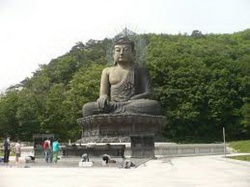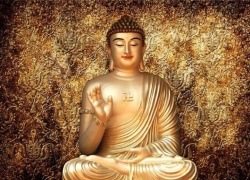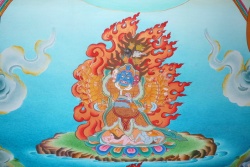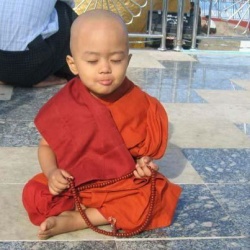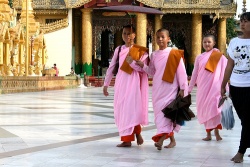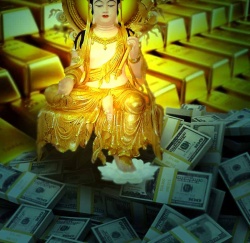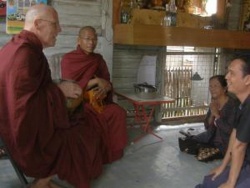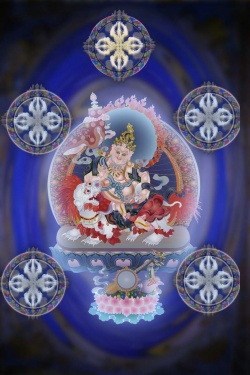Difference between revisions of "Vajrayana and Tantrism"
(Created page with " The third category, Vajrayana or Tantrayana, which derives from Mahayana, is the school most closely associated with Tibetan Buddhism -- so integral a...") |
|||
| Line 1: | Line 1: | ||
| + | <nomobile>{{DisplayImages|1503|4090|1124|537|2917|4370|2215|4343}}</nomobile> | ||
| Line 7: | Line 8: | ||
| + | The third category, [[Vajrayana]] or [[Tantrayana]], which derives from [[Mahayana]], is the school most closely associated with [[Tibetan Buddhism]] -- so integral a part of it that it has become virtually identified with the [[religion]] of [[Tibet]]. | ||
| − | + | The most [[mystical]] and [[esoteric]] of the schools, [[Tantric Buddhism]] is farthest from the common origin, and found little or no [[acceptance]] in [[southeast]] {{Wiki|Asia}}, where it is sometimes not even considered an [[Wikipedia:Authenticity|authentic]] school of [[Buddhism]]. | |
| − | [[Vajrayana]] or [[Tantrayana Buddhism]] involves [[mystical]] [[Wikipedia:concept|concepts]] and practices, some of which appear to depart sharply from central [[Buddhist precepts]]. In a relatively early [[book]] (1894) on [[Tibetan Buddhism]], {{Wiki|L. Austine Waddell}}, an English observer, called it a {{Wiki|cult}} whose [[name]], he wrote, should more properly be [[Lamaism]], as its divergence from [[Buddhism]] was so great. [[Wikipedia:Laurence Waddell|Waddell]] [[thought]] that some of its higher [[rituals]] invited comparison with {{Wiki|Catholicism}} (the resemblance is entirely [[superficial]]), but considered that many of its other practices were mere [[devil]] {{Wiki|worship}} or {{Wiki|sorcery}}. Having only a shallow [[understanding]] of [[Vajrayana]], [[Wikipedia:Laurence Waddell|Waddell]] regarded it as an {{Wiki|inferior}}, even primitive [[spiritual]] order. Yet so distinctively different are some aspects of [[Vajrayana]] that even [[Professor]] {{Wiki|Giuseppe Tucci}}, one of the most {{Wiki|distinguished}} [[scholars]] in the field, used the term "[[Lamaism]]" interchangeably with [[Buddhism]]. | + | The [[Wikipedia:concept|concepts]] and practices of [[tantrism]] originated in [[India]] and are associated with [[Shaivism]], the {{Wiki|cult}} of [[Shiva]], the [[god]] of [[Yogins]]. |
| + | |||
| + | It was from [[Indian]] sources that [[Mahayanists]] absorbed this {{Wiki|movement}}, and these two schools are exemplified in the great [[Lo Monthang]] [[gompas]]: [[Mahayana]] in Thubchen, and [[Vajrayana]] in [[Jampa]]. | ||
| + | |||
| + | |||
| + | [[Vajrayana]] or [[Tantrayana Buddhism]] involves [[mystical]] [[Wikipedia:concept|concepts]] and practices, some of which appear to depart sharply from central [[Buddhist precepts]]. | ||
| + | |||
| + | In a relatively early [[book]] (1894) on [[Tibetan Buddhism]], {{Wiki|L. Austine Waddell}}, an English observer, called it a {{Wiki|cult}} whose [[name]], he wrote, should more properly be [[Lamaism]], as its divergence from [[Buddhism]] was so great. | ||
| + | |||
| + | [[Wikipedia:Laurence Waddell|Waddell]] [[thought]] that some of its higher [[rituals]] invited comparison with {{Wiki|Catholicism}} (the resemblance is entirely [[superficial]]), but considered that many of its other practices were mere [[devil]] {{Wiki|worship}} or {{Wiki|sorcery}}. | ||
| + | |||
| + | Having only a shallow [[understanding]] of [[Vajrayana]], [[Wikipedia:Laurence Waddell|Waddell]] regarded it as an {{Wiki|inferior}}, even primitive [[spiritual]] order. | ||
| + | |||
| + | Yet so distinctively different are some aspects of [[Vajrayana]] that even [[Professor]] {{Wiki|Giuseppe Tucci}}, one of the most {{Wiki|distinguished}} [[scholars]] in the field, used the term "[[Lamaism]]" interchangeably with [[Buddhism]]. | ||
| + | |||
| + | |||
| + | |||
| + | [[Tantrism]] is a profoundly complex [[subject]]. | ||
| + | |||
| + | |||
| + | It might be described as an alternative route to [[enlightenment]], requiring intense [[concentration]] and induction through special [[rites]] of [[initiation]], but [[offering]] the {{Wiki|hope}} of achieving [[enlightenment]] in accelerated time, perhaps even in a single [[lifetime]]: a sort of [[spiritual]] shortcut. | ||
| + | |||
| + | The way of [[Mahayana]], the way of the [[Bodhisattva]], is considered the slower way, requiring many lifetimes to achieve, whereas [[Vajrayana]], the [[tantric]] way, is a faster, although more risky route. | ||
| + | |||
| + | Sometimes known as [[Mantrayana]], it uses [[mantric]] [[formulas]], incantation, [[ritual]], and [[magic]] to achieve power over [[supramundane]] [[beings]] and, ultimately, to transcend the [[self]] and become one with the [[deity]]. | ||
| + | |||
| + | This is [[Buddhism]] in its least recognizable [[appearance]], the [[form]] most difficult to adapt or reconcile with what are [[traditionally]] regarded as the original [[teachings of the Buddha]] [[Shakyamuni]]. | ||
| + | |||
| + | Yet, although [[Vajrayana]] is almost {{Wiki|synonymous}} with [[Tibetan Buddhism]], its [[roots]] are in [[India]]. | ||
| + | |||
| + | |||
| + | |||
| + | [[Tantrism]] derives from [[Indian]] texts, the [[Tantras]], which provide the {{Wiki|theory}} and describe practices of [[ritual]] [[yoga]], as in a dramatic [[script]]. | ||
| + | |||
| + | The [[yoga]] that has achieved [[popularity]] in the [[western world]] is a very late and only remotely recognizable offshoot of an [[ancient]] [[mystic]] {{Wiki|concept}}. | ||
| + | |||
| + | [[Yoga]] made use of certain [[physical]] [[disciplines]] and practices to achieve the mystic's goal, the exercises being a subordinate [[element]]. | ||
| + | |||
| + | Rather than a {{Wiki|training}} for [[mystical]] [[experience]], aiming for a [[state]] of [[spiritual]] [[transformation]], the [[yoga]] now popular in the [[West]] is often a system of [[physical]] exercise that makes use of [[breath control]], | ||
| + | |||
| + | [[offering]] enhanced [[flexibility]], improved [[balance]], [[relaxation]] of tension, and a [[sense]] of rejuvenation. | ||
| + | |||
| + | |||
| + | The [[serenity]] thus gained by a [[relaxed]] [[body]], regulated [[breathing]], and [[calm]] [[mind]] is meant to provide a [[spiritual]] [[benefit]] as well. | ||
| + | |||
| + | But although [[tantric yoga]] makes use of [[physical]] as well as [[mental]] [[discipline]], it aims for much more than the [[physical]] benefits of [[flexibility]] and [[balance]], or the [[tranquility]] of a [[calm]] [[mind]] in a [[calm]] [[body]]. | ||
| + | |||
| + | It is based on the [[principle]] that the [[duality]], the separation, of [[spirit]] and {{Wiki|matter}} is an [[illusion]], and its goal is the transcendance of such [[delusion]] into [[mystical]] union with the [[divine]]. | ||
| + | |||
| + | The [[yogin]], transported to another [[state]] of [[existence]], reaches the [[Wikipedia:Absolute (philosophy)|ultimate]] [[state of bliss]], of beatitude. Sometimes referred to as "[[ecstasy]]," this is not the [[ecstasy]] of Dionysiac frenzy, but rather of {{Wiki|perfect}} [[serenity]], of still, untroubled [[consciousness]]. | ||
| − | |||
| − | |||
| − | |||
The [[state]] of union with the [[divine]] is [[symbolically]] represented in [[Buddhist tantric]] [[art]] by a depiction of {{Wiki|sexual}} embrace between the [[divinity]] and his [[consort]] in the [[attitude]] known as "[[yab-yum]]" (see below). | The [[state]] of union with the [[divine]] is [[symbolically]] represented in [[Buddhist tantric]] [[art]] by a depiction of {{Wiki|sexual}} embrace between the [[divinity]] and his [[consort]] in the [[attitude]] known as "[[yab-yum]]" (see below). | ||
| Line 21: | Line 69: | ||
In depicting the highly [[symbolic]] and non-naturalistic [[visions]] of [[Tibetan Buddhist art]], the artist was in an {{Wiki|ideal}} [[sense]] a [[yogi]], who could thus convey the type of [[spiritual]], extra-sensory [[vision]] required for this [[art]]. | In depicting the highly [[symbolic]] and non-naturalistic [[visions]] of [[Tibetan Buddhist art]], the artist was in an {{Wiki|ideal}} [[sense]] a [[yogi]], who could thus convey the type of [[spiritual]], extra-sensory [[vision]] required for this [[art]]. | ||
| − | The [[Wikipedia:concept|concepts]] and practices of [[tantrism]] in the [[Buddhist universities]] of {{Wiki|eastern India}} have been dated at least to the eighth century, from which time translations have survived, yet the {{Wiki|theory}} and some of the texts may be several centuries older. In its origin and later [[development]] in [[India]], it is connected with [[Shaivism]], [[rites]] performed by [[yogins]], followers of the [[Hindu god]] [[Shiva]]. The influence of those [[ideas]] and practices reached the great [[Buddhist]] [[monastic]] [[universities]] that flourished in {{Wiki|eastern India}}, and which were at their prime between the seventh and eleventh centuries. Some of the [[tantric]] [[masters]] who became known as [[mahasiddhas]] -- great {{Wiki|adepts}}, [[master]] [[yogins]] -- were not necessarily [[attached]] to the [[monastic]] [[universities]] and the {{Wiki|rules}} of the [[monastic]] orders, but were freely wandering [[yogins]]. | + | |
| + | |||
| + | The [[Wikipedia:concept|concepts]] and practices of [[tantrism]] in the [[Buddhist universities]] of {{Wiki|eastern India}} have been dated at least to the eighth century, from which time translations have survived, yet the {{Wiki|theory}} and some of the texts may be several centuries older. | ||
| + | |||
| + | In its origin and later [[development]] in [[India]], it is connected with [[Shaivism]], [[rites]] performed by [[yogins]], followers of the [[Hindu god]] [[Shiva]]. | ||
| + | |||
| + | The influence of those [[ideas]] and practices reached the great [[Buddhist]] [[monastic]] [[universities]] that flourished in {{Wiki|eastern India}}, and which were at their prime between the seventh and eleventh centuries. | ||
| + | |||
| + | Some of the [[tantric]] [[masters]] who became known as [[mahasiddhas]] -- great {{Wiki|adepts}}, [[master]] [[yogins]] -- were not necessarily [[attached]] to the [[monastic]] [[universities]] and the {{Wiki|rules}} of the [[monastic]] orders, but were freely wandering [[yogins]]. | ||
| + | |||
| + | |||
Arcane as [[Tantrism]] may seem, neither [[Tibetan Buddhism]] nor [[Tibetan art]] can be understood without this fundamental {{Wiki|concept}}. | Arcane as [[Tantrism]] may seem, neither [[Tibetan Buddhism]] nor [[Tibetan art]] can be understood without this fundamental {{Wiki|concept}}. | ||
| − | Although its divergence from "original" [[Buddhism]] may appear extreme, and despite its [[mysticism]] and [[Wikipedia:aura (paranormal)|aura]] of [[magic]], followers and [[scholars]] of [[Vajrayana | + | Although its divergence from "original" [[Buddhism]] may appear extreme, and despite its [[mysticism]] and [[Wikipedia:aura (paranormal)|aura]] of [[magic]], |
| + | |||
| + | |||
| + | |||
| + | followers and [[scholars]] of [[Vajrayana Tantrism]] hold it to be authentically [[Buddhist]] in its [[essence]], [[affirming]] the [[interdependence]] of all things and thus the illusive [[nature]] of [[duality]], and the [[truth]] of the interaction of [[cause and effect]]. | ||
| + | |||
| + | [[Mahayanists]] hold that in each of us may be found the [[desired]] "[[Buddha-nature]]," which we can learn to uncover. | ||
| + | |||
| + | [[Vajrayana]] goes farther, claiming that by cutting through misconceptions and [[delusions]], one can {{Wiki|perceive}} the deepest [[reality]], the fundamental {{Wiki|unity}} of [[phenomena]]. | ||
| + | |||
| + | Because of the [[latter]] [[idea]], [[Vajrayana]] can appear to hold [[good and evil]] to be {{Wiki|equivalent}}, but that is a misinterpretation. | ||
| + | |||
| + | |||
| + | Moreover, some [[tantric]] texts refer to practices (involving [[foods]], [[physical]] functions, {{Wiki|sexual}} acts, and even [[immoral]] acts) that contravene [[essential]] [[Buddhist teachings]]. | ||
| + | |||
| + | Questions about the historicity of such practices, and whether they are meant to be viewed [[symbolically]] rather than understood literally, are complex and disputed. | ||
| + | |||
| + | Because of the [[risk]] of misinterpretation of [[Vajrayana]] texts and [[Wikipedia:concept|concepts]], even when they are understood [[symbolically]], and because of the [[risk]] of other misdirections, [[Vajrayana]] emphasizes the necessity of having a [[spiritual guide]], a [[teacher]] or "[[guru]]," to lead one through the complexities of meaning and practice. | ||
| + | |||
| + | |||
| + | [[Meditation]], above all, is considered the key to reaching [[transcendent]] [[understanding]] and [[spiritual]] [[transformation]], and the [[great vehicle]] for [[meditation]] is the [[mandala]]. | ||
| − | + | [[Jampa]], entirely painted with [[mandalas]], is a fully [[tantric]] [[temple]]. | |
| + | {{R}} | ||
| + | http://library.brown.edu/cds/BuddhistTempleArt/buddhism2.html | ||
| + | [[Category:Vajrayana]] | ||
Latest revision as of 16:29, 9 December 2015
The third category, Vajrayana or Tantrayana, which derives from Mahayana, is the school most closely associated with Tibetan Buddhism -- so integral a part of it that it has become virtually identified with the religion of Tibet.
The most mystical and esoteric of the schools, Tantric Buddhism is farthest from the common origin, and found little or no acceptance in southeast Asia, where it is sometimes not even considered an authentic school of Buddhism.
The concepts and practices of tantrism originated in India and are associated with Shaivism, the cult of Shiva, the god of Yogins.
It was from Indian sources that Mahayanists absorbed this movement, and these two schools are exemplified in the great Lo Monthang gompas: Mahayana in Thubchen, and Vajrayana in Jampa.
Vajrayana or Tantrayana Buddhism involves mystical concepts and practices, some of which appear to depart sharply from central Buddhist precepts.
In a relatively early book (1894) on Tibetan Buddhism, L. Austine Waddell, an English observer, called it a cult whose name, he wrote, should more properly be Lamaism, as its divergence from Buddhism was so great.
Waddell thought that some of its higher rituals invited comparison with Catholicism (the resemblance is entirely superficial), but considered that many of its other practices were mere devil worship or sorcery.
Having only a shallow understanding of Vajrayana, Waddell regarded it as an inferior, even primitive spiritual order.
Yet so distinctively different are some aspects of Vajrayana that even Professor Giuseppe Tucci, one of the most distinguished scholars in the field, used the term "Lamaism" interchangeably with Buddhism.
Tantrism is a profoundly complex subject.
It might be described as an alternative route to enlightenment, requiring intense concentration and induction through special rites of initiation, but offering the hope of achieving enlightenment in accelerated time, perhaps even in a single lifetime: a sort of spiritual shortcut.
The way of Mahayana, the way of the Bodhisattva, is considered the slower way, requiring many lifetimes to achieve, whereas Vajrayana, the tantric way, is a faster, although more risky route.
Sometimes known as Mantrayana, it uses mantric formulas, incantation, ritual, and magic to achieve power over supramundane beings and, ultimately, to transcend the self and become one with the deity.
This is Buddhism in its least recognizable appearance, the form most difficult to adapt or reconcile with what are traditionally regarded as the original teachings of the Buddha Shakyamuni.
Yet, although Vajrayana is almost synonymous with Tibetan Buddhism, its roots are in India.
Tantrism derives from Indian texts, the Tantras, which provide the theory and describe practices of ritual yoga, as in a dramatic script.
The yoga that has achieved popularity in the western world is a very late and only remotely recognizable offshoot of an ancient mystic concept.
Yoga made use of certain physical disciplines and practices to achieve the mystic's goal, the exercises being a subordinate element.
Rather than a training for mystical experience, aiming for a state of spiritual transformation, the yoga now popular in the West is often a system of physical exercise that makes use of breath control,
offering enhanced flexibility, improved balance, relaxation of tension, and a sense of rejuvenation.
The serenity thus gained by a relaxed body, regulated breathing, and calm mind is meant to provide a spiritual benefit as well.
But although tantric yoga makes use of physical as well as mental discipline, it aims for much more than the physical benefits of flexibility and balance, or the tranquility of a calm mind in a calm body.
It is based on the principle that the duality, the separation, of spirit and matter is an illusion, and its goal is the transcendance of such delusion into mystical union with the divine.
The yogin, transported to another state of existence, reaches the ultimate state of bliss, of beatitude. Sometimes referred to as "ecstasy," this is not the ecstasy of Dionysiac frenzy, but rather of perfect serenity, of still, untroubled consciousness.
The state of union with the divine is symbolically represented in Buddhist tantric art by a depiction of sexual embrace between the divinity and his consort in the attitude known as "yab-yum" (see below).
In depicting the highly symbolic and non-naturalistic visions of Tibetan Buddhist art, the artist was in an ideal sense a yogi, who could thus convey the type of spiritual, extra-sensory vision required for this art.
The concepts and practices of tantrism in the Buddhist universities of eastern India have been dated at least to the eighth century, from which time translations have survived, yet the theory and some of the texts may be several centuries older.
In its origin and later development in India, it is connected with Shaivism, rites performed by yogins, followers of the Hindu god Shiva.
The influence of those ideas and practices reached the great Buddhist monastic universities that flourished in eastern India, and which were at their prime between the seventh and eleventh centuries.
Some of the tantric masters who became known as mahasiddhas -- great adepts, master yogins -- were not necessarily attached to the monastic universities and the rules of the monastic orders, but were freely wandering yogins.
Arcane as Tantrism may seem, neither Tibetan Buddhism nor Tibetan art can be understood without this fundamental concept.
Although its divergence from "original" Buddhism may appear extreme, and despite its mysticism and aura of magic,
followers and scholars of Vajrayana Tantrism hold it to be authentically Buddhist in its essence, affirming the interdependence of all things and thus the illusive nature of duality, and the truth of the interaction of cause and effect.
Mahayanists hold that in each of us may be found the desired "Buddha-nature," which we can learn to uncover.
Vajrayana goes farther, claiming that by cutting through misconceptions and delusions, one can perceive the deepest reality, the fundamental unity of phenomena.
Because of the latter idea, Vajrayana can appear to hold good and evil to be equivalent, but that is a misinterpretation.
Moreover, some tantric texts refer to practices (involving foods, physical functions, sexual acts, and even immoral acts) that contravene essential Buddhist teachings.
Questions about the historicity of such practices, and whether they are meant to be viewed symbolically rather than understood literally, are complex and disputed.
Because of the risk of misinterpretation of Vajrayana texts and concepts, even when they are understood symbolically, and because of the risk of other misdirections, Vajrayana emphasizes the necessity of having a spiritual guide, a teacher or "guru," to lead one through the complexities of meaning and practice.
Meditation, above all, is considered the key to reaching transcendent understanding and spiritual transformation, and the great vehicle for meditation is the mandala.
Jampa, entirely painted with mandalas, is a fully tantric temple.
Source
http://library.brown.edu/cds/BuddhistTempleArt/buddhism2.html
